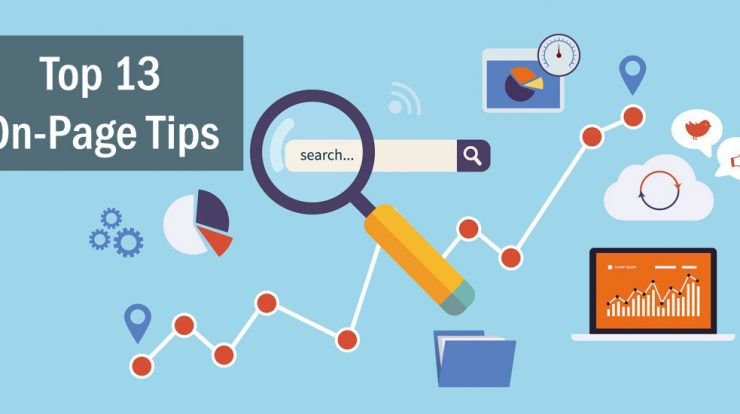
Online business in this competitive market is all about ranking these days. Who in this world does not want a rank higher than the other?
Ranking being the first and foremost need of the time is now seen as the most focused thing in terms of SEO.
*The study by Infront Webworks says that the first page of Google receives almost 95 percent of visitors’ web traffic, while others receive the remaining 5%.
Source: https://www.infront.com/blogs/the-infront-blog/2015/6/17/value-of-first-page-google-results
Today, we at AGM brought you the Top 13 On-Page Tips to Rank High on Google so that you too can stand with a proud among those Top competitors.
Take a Look-
1. Title- Title as the name suggests is the mirror of your web pages. As all say- The first Impression is the last impression. Anyone will decide to move further by your title alone.
It can be included by the Title Tag in the HTML element of your web page and should ideally be approx. 50-60 characters long.
The HTML code with Title Tag will look like-
<head>
<title> Sample title</title>
</head>
2. Heading – H1 tag being the most important and further H2 and H3 Tags for sectional breaks in your page is a must do practice for on page optimization.
It is used to define the heading and all-together purpose of that particular page so that user can get the idea what he is going to get further on your web page.
3. Meta Description- Meta is data about your data and similar to the above given two points, it also serves the purpose of making your web page understanding clear and concise to your user.
Basically, it consists of 150-160 characters and appears as the description that user gets to see under the clickable link of your page on Google.
HTML element of meta description looks as follows-
<head>
<meta name=”description” content=”Sample meta description.”>
</head>
4. Content- You will only get the right set of audience with properly focused content. The content quality should be plagiarism free, and it should be understandable to the readers.
All-in-all it should be readable, linkable, informational and useful for the visitors of your page.
5. Keywords- When you talk about the content, how can keywords be ignored. In digital marketing field, content without proper keywords is like a pond without water.
The focused keywords should be relatable and must be used while optimizing the content.
Keyword stuffing is highly un-recommended for quality content. Hence, it is suggested that keyword density should ideally be 1-3% of the total content and should be done in the most natural manner.
6. Internal Linking- Related blog posts should be linked internally to drag users to the other pages. It increases the time that user stays at your site and hence increases the ranking and popularity of your blog post.
7. External Linking- Equally important as internal linking, the external linking activity is done by using the external links to other popular sites. The only condition is the other sites, which you are targeting for external link building should be trustable and authentic. One can also use the no follow attribute to play safely in this area.
8. Word Count – The more you write, the more will be the possibility to rank. Average no of words in a blog post is minimum 500 words but to be excellent in content; you should write at least 1000 words blog to perform well in Google rankings.
9. Images- The images that you plan to use inside your blog posts should be compressed and optimized to maintain the interest of your visitors. The big images with more loading time are highly un-recommended for site performance.
“Image title” and “Image alt attribute” should also be focused to do the image optimization in a better way.
10. URL- Improve the relevant and useful visits to your blog post or site with appropriate explanatory URL. The hierarchy should be self-explanatory in the URL to make it clearly understandable and more targeted to the audience.
11. Page Load Speed– The page load speed is important for better user experience and can be improved by-
• Optimization of codes, images and massive files on your page.
• Reducing Re-directs and leveraging browser caching properly.
12. UX- UX/ User Experience is all that we are talking about since the starting of this article. Make your site easy to navigate, simple, quick and attractive for best user experiences.
13. Shareability- Your content should be easily sharable so that user get to share it with their circles and unknowingly make it popular among the masses and you know it very well, the popular content ranks the most and will give you desired profitable output.
Try these tips, and we bet you will get the improved SER (Search Engine Rankings) in short time.
You can also let us do all these things for you and get the desired results with 0 effort.
Resource: agmsearchindia
